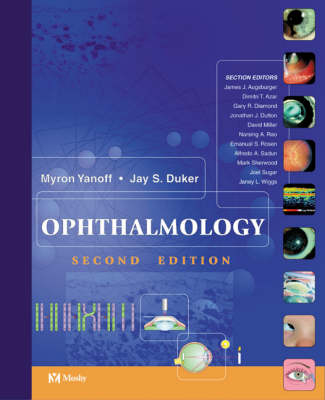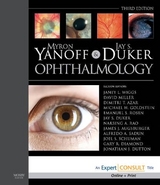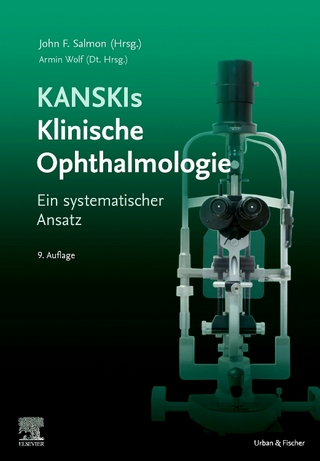
Ophthalmology
Mosby (Verlag)
978-0-323-01634-6 (ISBN)
- Titel erscheint in neuer Auflage
- Artikel merken
This state-of-the-art reference covers every aspect of ophthalmology, combining the latest on genetics, diagnostic tips and techniques, proven management strategies, surgical approaches, new drugs and more. An esteemed author team and contributions of hundreds of top-tier practitioners provide trustworthy guidance on practically every ophthalmic condition and procedure. It is filled with an impressive collection of 2,500 detailed photographic images.
PART 1: Genetics and Ocular Embryology 1. Fundamentals of human genetics 2. Molecular genetics of selected ocular disorders 3. Embryology of the eye PART 2. Optics and Refraction 4. Visible light 5. Physical optics for clinicians 6. Light damage to the eye 7. Principles of lasers 8. Light units 9. Optics of the normal eye 10. Epidemiology of refractiive errors 11. Subjective testing of refraction 12. Contact lenses 13. Ophthalmic instrumentation 14. Perspectives on aberrations of the eye PART 3. Refractive Surgery 15. Introduction to refractive surgery 16. Preoperative evaluation for refractive surgery 17. Radial and astigmatiic keratotomy 18. Excimer laser photorefractiive keratectomy 19. Automated and manual lamellar surgical prodecures and epikeratoplasty 20. LASIK - Indications and techniques 21. LASIK - Complications 22. Management of LASIK complications 23. LASEK 24. LTK 25. Intracorneal rings and implants 26. Phakic IOLs 27. Refractve aspects of cataract surgery PART 4: The Lens Section 1: BASIC SCIENCE OF THE LENS 28. Anatomy 29. Physiology 30. Biophysics 31. Biochemistry 32. Evolution and molecular biology 33. Age changes 34. Secondary cataract Section 2: CATARACT 35. Pathophysiology 36. Cataract formaton mechanisms 37. Epidemiology, morphology, and visual effects of lens opacities of cataract Section 3: LENS REPLACEMENT 38. Optics of aphakia 39. Pseudophakia and measurements 40. Evolution and pathology of intracular lens implantation 41. Corneal topography in cataract surgery Section 4: LENS SURGERY 42. Indications for lens surgery and technical options 43. Patent workup for cataract surgery 44. The pharmacotherapy of cataract surgery 45. Anesthesia for cataract surgery 46. The mechanical and hydrodynamic aspects of phacoemulsification 47. Small incision cataract surgery 48. Manual cataract extraction 49. Combined procedures 50. Cataract surgery in complicated eyes 51. Management of eyes after small incision phacoemulsification and lens implantaton 52. Pediatric cataract surgery Section 5: COMPLICATIONS AND OUTCOMES 53. Complications of cataract surgery 54. Outcomes of cataract surgery PART 5: Cornea and External Disease 55. Disorders of the conjunctiva and limbus 56. Corneal epithelium 57. Corneal endothelium 58. Congenital corneal anomalies 59. Stromal corneal dystrophies and ectasias 60. Conjunctival and corneal degenerations 61. Non-infectious keratitis 62. Infectious keratitis 63. Corneal and conjunctival surgery 64. Episcleritis, sclertis and other scleral disorders 65. Dry-eye 66. Cornea and external eye manifestations of systemic disease 67. Epibulbar tumors PART 6: Strabismus Section 1: BASIC SCIENCE 68. Anatomy and physiology of the extraocular muscles and surrounding tissue Section 2: EVALUATION AND DIAGNOSIS 69. Evaluating vision in preverbal and preliterate infants and children 70. Evaluation of ocular alignment and eye moments 71. Sensory adaptations in strabismus Section 3: OCULAR MANIFESTATIONS 72. Sensory status in strabismus 73. Esotropia 74: Exotropia 75. Obilque muscle dysfunctions 76. Alphabet pattern strabismus 77. Paralytc strabismus 78. Other vertical strabismus forms 79. Amblyopia Section 4: TREATMENT 80. Forms of non-surgical strabismus management 81. Techniques of strabismus surgery PART 7: Orbit and Oculoplastics Section 1: ORBITAL AND ANATOMY AND IMAGING 82. Clinical anatomy of the eyelids 83. Clinical anatomy of the orbit 84. Orbital imaging techniques Section 2: EYELIDS 85. Eyelid retraction 86. Blepharoptosis 87. Entropion 88. Ectropion 89. Cosmetic blepharoplasty and brow plasty 90. Esthetic laser surgery 91. Essential blepharospasm 92. Benign eyelid lesions 93. Eyelid malignancies 94. Eyelid trauma and reconstruction techniques Section 3: ORBIT AND LACRIMAL GLAND 95. Orbital diseases 96. Orbital surgery 97. Enucleation, evisceration and exenteration 98. The lacrimal drainage system PART 8: Retina and Vitreous Section 1: BASIC SCIENCE 99. Structure and function of the neural retina 100. The retinal pgment epithelium 101. Retinal and choroidal circulaton Section 2: BASIC PRINCIPLES OF RETINAL SURGERY 102. Basic principles of laser photocoagulation 103. Scleral bucklng surgery 104. Vitrectomy Section 3: ANCILLARY TESTS 105. Contact B-scan ultrasonography 106. Fluorescein angiography and ICG 107. Electrophysiology Section 4: DYSTROPHIES 108. Retinitis pigmentosa and related disorders 109. Macular dystrophies 110. Choroidal dystrophies 111. Congenital statiionary night blindness 112. Hereditary bitreoretinopathies Section 5: VASCULAR DISORDERS 113. Hypertensive retinopathy 114. Retinal arterial obstruction 115. Venous obstructive disease of the retina 116. Retinopathy of prematurity 117. Diabetic retinopathy 118. Ocular schemic syndrome 119. Hemoglobinopathies 120. Coats' disease and retinal telangiectasis 121. Radiation retinopathy and papillopathy 122. Prolferative retinopathies 123. Retinal arterial macroaneurysms Section 6: MACULAR DISORDERS 124. Choroidal neovascularization 125. Age-related macular degeneration 126. Degenerative myopia 127. Central serous chororetinopathy 128. Macular hole 129. Epiretinal membrane 130. Vitreomacular traction syndrome 131. Cystoid macular edema 132. Coexistent optic nerve and macular abnormalties 133. Angioid streaks Section 7: RETINAL DETACHMENT 134. Peripheral retinal lesions 135. Retinal breaks 136. Rhegmatogenous retinal detachment 137. Serous detachment of the neural retina 138. Choroidal hemorrhage 139. Proliferatve vitreoretnopathy Section 8: TRAUMA 140. Posterior segment ocular trauma 141. Distant trauma with posterior segment effects 142. Light toxicity and laser burns 143. Toxic retinopathies Section 9: RETNAL DETACHMENT/VTREOUS 144. Vitreous anatomy and pathology 145. Persistent hyerplastic primary vitreous PART 9: Intraocular Tumors Section 1: MALIGNANT NTRAOCULAR TUMORS 146. Retinoblastoma 147. Uveal melanoma 148. Metastatic cancer to the eye 149. Lymphoma and leukemia 150. Medullpithelioma Section 2: BENIGN INTRAOCULAR TUMORS 151. Uveal nevus 152. Choroidal hemangiomas 153. Choroidal osteoma 154. Astrocytoma of retina 155. Hemangiomas of retina 156. Combined hamartoma 157. Hypertrophy of retinal pigment epithelium Section 3: PHAKOMATOSES 158. Phakomatoses Part 10: Uveitis and Other Intraocular Inflammations Section 1: BASIC PRINCIPLES 159. Mechanisms of uveitis 160. Anatomy of the uvea 161. General approach to uveitis patient and treatment strategies Section 2: INFECTIOUS CAUSES OF UVEITIS-VIRAL 162. Herpes and other viral infections 163. Cytomegalovirus retinitis (CMVR) in AIDS 164. HIV-related uveitis (includes PORN and other infections) Section 3: INFECTIOUS CAUSES OF UVEITIS- BACTERIAL 165. Syphilis 166. Tuberculosis, leprosy and brucellosis 167. Spirochete infections: Lyme disease and leptospirosis 168. Cat scratch and Whipple's disease 169. Endophthalmitis Section 4: INFECTIOUS CAUSES OF UVEITIS-FUNGAL 170. Histoplasmosis 171. Fungal endophthalmitis (Candidiasis, Aspergillosis, Coccidiodomycosis) Section 5: INFECTIOUS CAUSES OF UVEITIS-PROTOZOAL AND PARASITIC 172. Ocular toxoplasmosis 173. Posterior parasitic uveitis Section 6: UVEITIS ASSOCIATED WITH SYSTEMIC DISEASE 174. Uveitis related to HLA-B27 and juvenile arthritis 175. Sarcoidosis 176. Behcets disease 177. Vogt-Koyanagi-Harada disease Section 7: TRAUMATIC UVEITIS 178. Phacoantigenic uveitis 179. Sympathetic ophthalmia Section 8: UVEITIS OF UNKNOWN CAUSES 180. Idiopathic and other anterior uveitis syndromes 181. Intermediate uveitis 182. Posterior uveitis of unknown cause Section 9: MASQUERADE SYNDROMES 183. Ocular neoplasms related to HIV 184. Masquerade syndromes: neoplasms PART 11: Neuro-Ophthalmology Section 1: IMAGING IN NEUROOPHTHALMOLOGY 185. Principles of imaging in neuro-ophthalmology Section 2: THE AFFERENT VISUAL SYSTEM 186. Anatomy and physiology 187. Differntiation of optical nerve from retinal macular disease 188. Congenital optic disc anomalies 189. Papilledema and raised intracranial pressure 190. Inflammatory optic neuropathies and neuroretinitis 191. Ischemic optic neuropathy, diabetic papillopathy and papilliphlebitis 192. Hereditary, nutritional, and toxic optic atrophies 193. Prechiasmal pathways - compression by optic nerve and sheath tumors 194. Traumatic optic neuropathies 195. The optic chiasm, parasellar region and pituitary fossa 196. Retrochiasmal pathways, higher cortical function, nonorganic Section 3: THE EFFERENT VISUAL SYSTEM 197. Disorders of supranuclear control of ocular motility 198. Nuclear and fascicular disorders of eye movement 199. Paresis of isolated and multiple cranial nerves and painful ophthalmoplegias 200. Disorders of the neuromuscular junction 201. Ocular Myopathies 202. Nystagmus, saccadic intrusions and oscillations 203. The pupils 204. Loss of accommodation prebyopia Section 4: THE BRAIN 205. Headache and facial pain 206. Tumors, infections, inflammations and neurodegenerative diseases Section 5: NEUROOPHTHALMOLOGIC EMERGENCIES 207. Most urgent pathologies 208. Trauma, drugs and toxins 209. Vascular disorders PART 12: Glaucoma Section 1: EPIDEMIOLOGY AND MECHANISMS OF GLAUCOMA 210: Epidemiology of glaucoma 211. Screening for glaucoma 212. Mechanisms of glaucoma Section 2: EVALUATION AND DIAGNOSIS 213. Clinical examination of glaucoma 214. Visual field perimetry testing in glaucoma 215. Other psychophysical tests for glaucoma 216. Disc Analysis 217. Retinal nerve fiber layer analysis 218. Optic nerve blood flow measurement Section 3: SPECIFIC TYPES OF GLAUCOMA 219. Congenital glaucoma 220. Primary open-angle glaucoma 221. Normal tension glaucoma 222. Angle closure glaucoma 223. Pseudoex foliative glaucoma 224. Pigmentary glaucoma 225. Neovascular glaucoma 226. Ocular inflammatory and steroid-induced glaucoma 227. Post-trauma glaucoma 228. Raised episcleral venous pressure 229. Aqueous misdirection syndrome 230. Glaucoma associated with abnormalities of cornea and iris, tumors and retinal disease Section 4: THERAPY 231. When to treat glaucoma? 232. Which therapy to use in glaucoma? 233. Current medical management of glaucoma 234. New (pending) glaucoma medical therapy 235. Argon laser trabeculophasty and peripheral iridectomy 236. Laser filtration procedures 237. Cyclodestructive procedures in glaucoma 238. Goniotomy and trabeculotomy 239. Non-renetrating glaucoma surgery 240. Trabeculectomy 241. Antifibrotic agents n glaucoma surgery 242. Drainage implants 243. Complications of glaucoma surgery and their management
| Erscheint lt. Verlag | 9.9.2003 |
|---|---|
| Zusatzinfo | Approx. 2200 illustrations (over 1600 in full color) |
| Verlagsort | St Louis |
| Sprache | englisch |
| Maße | 246 x 189 mm |
| Gewicht | 5350 g |
| Themenwelt | Medizin / Pharmazie ► Medizinische Fachgebiete ► Augenheilkunde |
| ISBN-10 | 0-323-01634-0 / 0323016340 |
| ISBN-13 | 978-0-323-01634-6 / 9780323016346 |
| Zustand | Neuware |
| Informationen gemäß Produktsicherheitsverordnung (GPSR) | |
| Haben Sie eine Frage zum Produkt? |
aus dem Bereich



